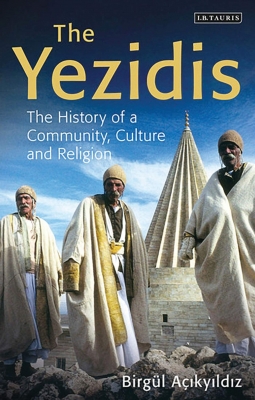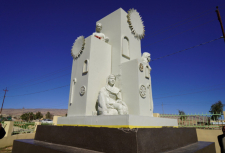The Yezidis: The History of a Community, Culture and Religion

Author- Birgul Ackyldz
Part-1
Few people had heard about the Yezidis until summer 2014, when world public opinion galvanized to rescue them from the group now known as Islamic State. The Yezidis are an ancient people whose faith started in the Kurdish mountains of northern Iraq in the 12th century. The Yezidis bear a cultural and belief system inspired by Zoroastrianism, Christianity, and Islam, with rituals such as a haircut after birth, circumcision, and baptism. Despite their roots in monotheistic faiths, the Yezidis are often maligned by outsiders for their devotion to the Peacock Angel, or Tawûsi Melek, considered by the group’s adversaries to be the embodiment of Satan. In the paperback edition of her book “The Yezidis: The History of a Community, Culture and Religion,” which she has just released, Birgul Ackyldz -- a professor of art history at Artuklu University in Mardin -- provides a trove of information on the Yezidis. Readers will profoundly appreciate this many-layered text covering not only the Yezidis’ belief system and religion but also their material culture, including shrines, tombstones, and caves. The book stands out because it is the first to treat the Yezidis transnationally rather than focusing on their presence in individual nation-states, as previous studies have done. Based on the author’s doctoral dissertation, the book was translated from the original French to English by the author -- and unfortunately, to the publisher’s discredit, it has been edited inadequately and often fails to correct unidiomatic language. This issue notwithstanding, the vibrant and unusual character of the book prevails even in the translated version. Ackyld work differs starkly from other academic texts in that the author includes her personal experience among the Yezidi communities, ranging from a compelling personal narrative to interviews and photographs. Color photos would have brought the Yezidi culture even more vividly to life -- perhaps a second unfortunate casualty of the publisher’s apparent tight budget. All the same, the reader feels she is very much meeting a living culture rather than a historical relic. In this spirit, the introduction sets the tone of a travelogue and one hears echoes of Gertrude Bell’s great work “The Thousand and One Churches.” Like Bell, Ackyld has immersed herself in her subject matter. Demonstrating her passion, she speaks Kurdish, traveling deeply in Yezidi territories and investigating Yezidi sites, though skipping Bell’s spying-for-the-British bit.
Like Bell’s 1907 work, which emerged from her expeditions in Asia Minor and remains a standard text on Middle Byzantine architecture, Ackyld’s study will no doubt remain a foundational work on the Yezidis. The first chapter examines the origins, history and development of the Yezidis in Mesopotamia, Anatolia, Syria, and Transcaucasia. Here, we are reminded of the oral transmission of Yezidism, many years before certain sacred texts were published in the early 20th century (the earliest written sources on the Yezidi faith are in medieval Arabic and Syriac). The absence of written evidence on the early Yezidis has elevated myths, folk legends, and hymns as transmitters of their experience. This chapter also highlights challenges faced by the Yezidis, starting with the Middle Ages, living as minorities living under the Mongols, Safavids and Ottomans -- and later in the nation-states of Armenia, Iraq, Syria, and Turkey. The second chapter discusses the Yezidi religious belief system, highlighting elements such as the concept of God, Tawûsî Melek and the Trinity. We learn of Xwedê, the Yezidis’ single, eternal God -- creator of the universe, master of all things heavenly, and appointer of Tawûsî Melek, who handles all worldly affairs. The Peacock Angel is the most important figure in the Yezidi pantheon; the other two members of the Trinity are the youthful Sultan Êzîd and the elderly, monumental reformer of Yezidism ,Sheikh‘ Adi.
The author correspondingly discusses the representation of Satan in Peacock Angel imagery, drawing comparisons to images in other heterodox Middle East communities, namely the Druze, Takhtajis and Mandeans. Such regional comparisons hold the promise for further research on the Yezidis. Other details of the Yezidi faith earn mention, such as its caste system, based on a triad of sheikhs, pîrs and murîds -- the first two being of clerical nature and the third lay. Mythology also appears, in the creation stories of humanity, the cosmos and the universe. And the author also describes the links between Yezidism, ancient Mesopotamians, Greeks, and Romans, as well as Christianity and Islam.
The third chapter explains the Yezidis’ religious observances, practices, and rituals. Through the author’s eloquent descriptions, readers learn the reasons behind practices such as the haircut, conducted shortly after birth by a sheikh or murîd, rendering the child Yezidi; baptism, borrowed from pagan as well as Christian traditions again done by the sheikh or murîd; and circumcision, only for boys and conducted 20 days after birth. The author tells of the figure of the godfather; of arranged marriages and related protections against intermarriage; and of the Yazidi notions of reincarnation.
Tags: #yazidisinfo #newsyazidi #aboutyazidi #yezidis
The Yezidis: The History of a Community, Culture and Religion

Author- Birgul Ackyldz
Part-1
Few people had heard about the Yezidis until summer 2014, when world public opinion galvanized to rescue them from the group now known as Islamic State. The Yezidis are an ancient people whose faith started in the Kurdish mountains of northern Iraq in the 12th century. The Yezidis bear a cultural and belief system inspired by Zoroastrianism, Christianity, and Islam, with rituals such as a haircut after birth, circumcision, and baptism. Despite their roots in monotheistic faiths, the Yezidis are often maligned by outsiders for their devotion to the Peacock Angel, or Tawûsi Melek, considered by the group’s adversaries to be the embodiment of Satan. In the paperback edition of her book “The Yezidis: The History of a Community, Culture and Religion,” which she has just released, Birgul Ackyldz -- a professor of art history at Artuklu University in Mardin -- provides a trove of information on the Yezidis. Readers will profoundly appreciate this many-layered text covering not only the Yezidis’ belief system and religion but also their material culture, including shrines, tombstones, and caves. The book stands out because it is the first to treat the Yezidis transnationally rather than focusing on their presence in individual nation-states, as previous studies have done. Based on the author’s doctoral dissertation, the book was translated from the original French to English by the author -- and unfortunately, to the publisher’s discredit, it has been edited inadequately and often fails to correct unidiomatic language. This issue notwithstanding, the vibrant and unusual character of the book prevails even in the translated version. Ackyld work differs starkly from other academic texts in that the author includes her personal experience among the Yezidi communities, ranging from a compelling personal narrative to interviews and photographs. Color photos would have brought the Yezidi culture even more vividly to life -- perhaps a second unfortunate casualty of the publisher’s apparent tight budget. All the same, the reader feels she is very much meeting a living culture rather than a historical relic. In this spirit, the introduction sets the tone of a travelogue and one hears echoes of Gertrude Bell’s great work “The Thousand and One Churches.” Like Bell, Ackyld has immersed herself in her subject matter. Demonstrating her passion, she speaks Kurdish, traveling deeply in Yezidi territories and investigating Yezidi sites, though skipping Bell’s spying-for-the-British bit.
Like Bell’s 1907 work, which emerged from her expeditions in Asia Minor and remains a standard text on Middle Byzantine architecture, Ackyld’s study will no doubt remain a foundational work on the Yezidis. The first chapter examines the origins, history and development of the Yezidis in Mesopotamia, Anatolia, Syria, and Transcaucasia. Here, we are reminded of the oral transmission of Yezidism, many years before certain sacred texts were published in the early 20th century (the earliest written sources on the Yezidi faith are in medieval Arabic and Syriac). The absence of written evidence on the early Yezidis has elevated myths, folk legends, and hymns as transmitters of their experience. This chapter also highlights challenges faced by the Yezidis, starting with the Middle Ages, living as minorities living under the Mongols, Safavids and Ottomans -- and later in the nation-states of Armenia, Iraq, Syria, and Turkey. The second chapter discusses the Yezidi religious belief system, highlighting elements such as the concept of God, Tawûsî Melek and the Trinity. We learn of Xwedê, the Yezidis’ single, eternal God -- creator of the universe, master of all things heavenly, and appointer of Tawûsî Melek, who handles all worldly affairs. The Peacock Angel is the most important figure in the Yezidi pantheon; the other two members of the Trinity are the youthful Sultan Êzîd and the elderly, monumental reformer of Yezidism ,Sheikh‘ Adi.
The author correspondingly discusses the representation of Satan in Peacock Angel imagery, drawing comparisons to images in other heterodox Middle East communities, namely the Druze, Takhtajis and Mandeans. Such regional comparisons hold the promise for further research on the Yezidis. Other details of the Yezidi faith earn mention, such as its caste system, based on a triad of sheikhs, pîrs and murîds -- the first two being of clerical nature and the third lay. Mythology also appears, in the creation stories of humanity, the cosmos and the universe. And the author also describes the links between Yezidism, ancient Mesopotamians, Greeks, and Romans, as well as Christianity and Islam.
The third chapter explains the Yezidis’ religious observances, practices, and rituals. Through the author’s eloquent descriptions, readers learn the reasons behind practices such as the haircut, conducted shortly after birth by a sheikh or murîd, rendering the child Yezidi; baptism, borrowed from pagan as well as Christian traditions again done by the sheikh or murîd; and circumcision, only for boys and conducted 20 days after birth. The author tells of the figure of the godfather; of arranged marriages and related protections against intermarriage; and of the Yazidi notions of reincarnation.
Tags: #yazidisinfo #newsyazidi #aboutyazidi #yezidis


























